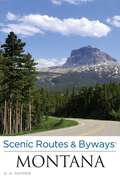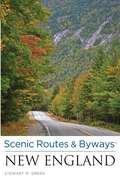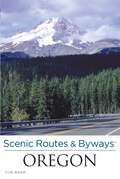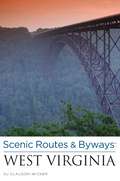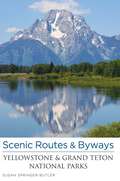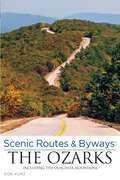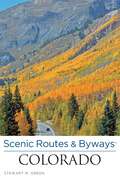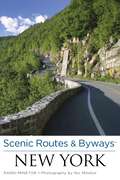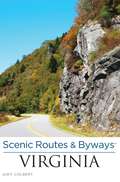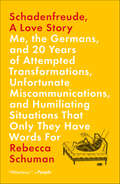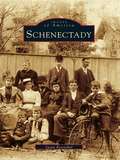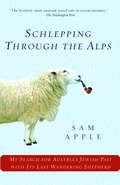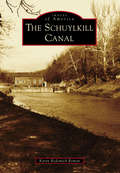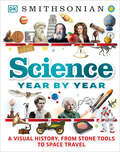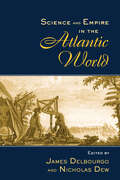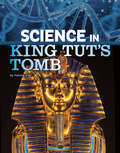- Table View
- List View
Scenic Routes & Byways Montana (Scenic Routes & Byways)
by S. A. SnyderPack up the car and enjoy twenty-four of the most memorable drives in the Treasure State. Offering over 2,250 miles of riding pleasure, this indispensable highway companion maps out unforgettable trips for exploring the region&’s scenic byways and back roads.Discover classic trails and beautiful areas of the state that many visitors miss, from Glacier National Park&’s magnificent Going-to-the-Sun Road in the northwest to the rugged rangelands and red-tinted badlands of eastern Montana. Along the way you&’ll discover ghost towns, glaciers, hot springs, and great hiking and wildlife-viewing opportunities—a mere taste of what the Big Sky Country has to offer. Inside you&’ll find Itineraries ranging from 49 to 175 miles in length Route maps for each drive In-depth descriptions of attractions along the way Optional side trips to museums, parks, and landmarks Tips on lodging, camping, dining, travel services, and best driving seasons
Scenic Routes & Byways New England (Scenic Routes & Byways)
by Stewart M. GreenPack up the car and enjoy gorgeous drives through some of the most spectacular scenery the area has to offer. This series of indispensable highway companions maps out short trips for exploring scenic byways and back roads. Whether you embark on an adventure that winds along mountainsides, cuts through open fields, or shows off the shoreline, the road trips in our Scenic Driving guides will transform your passenger seat into a front row seat to experience natural beauty at its finest.This spring, discover four newly-updated guides: Scenic Driving Montana, Scenic Driving New England, Scenic Oregon, and Scenic DrivingYellowstone and Grand Teton National Parks.Inside you&’ll find:Itineraries from 20 to more than 200 miles Route map for each drive In-depth descriptions of attractions Optional side trips to museums, parks, and landmarks Tips on lodging, camping, dining, travel services, and best driving seasons
Scenic Routes & Byways Oregon (Scenic Routes & Byways)
by Tom BarrPack up the car and enjoy forty-five memorable routes in the Beaver State. Featuring over 4,800 miles of riding pleasure, this indispensable highway companion maps out unforgettable trips for exploring the region&’s scenic byways and back roads.Embark on an adventure that winds along the mountainsides. Take in the magnificence of the Columbia River Gorge. Trek along a coastline that sports some of the earth&’s most spectacular scenery. Along the way you&’ll discover fertile farmlands, unspoiled wilderness, deserts filled with sagebrush, and breathtaking vineyards and orchards.Inside you&’ll findItineraries ranging from 5 to 325 miles in lengthFull-color photos and route maps for each drive In-depth descriptions of attractions along the wayOptional side trips to museums, parks, and landmarks Tips on lodging, camping, dining, travel services, and best driving seasons
Scenic Routes & Byways West Virginia (Scenic Routes & Byways)
by Su Clauson-WickerScenic Routes & Byways West Virginia features nearly twenty-five separate drives through the Mountain State, from rock ridges and gorges to springs, spas and rustic farms. An indispensable highway companion, Scenic Routes & Byways West Virginia includes route maps and in-depth descriptions of attractions.
Scenic Routes & Byways Yellowstone & Grand Teton National Parks (Scenic Routes & Byways)
by Susan Springer ButlerPack up the car and enjoy 28 gorgeous drives through the crown jewels of the National Park system—Yellowstone and Grand Teton. Offering nearly 1,200 miles of riding pleasure, this indispensable highway companion maps out short trips for exploring the region&’s scenic byways and back roads.Discover areas of Yellowstone and Grand Teton that many visitors miss, from marvelous Firehole Canyon to the ever-changing face of Norris Geyser Basin, from Flagg Ranch to the geologic wonders of the Gros Ventre Slide area.Inside you&’ll find:Itineraries ranging from 5 miles to 155 miles in lengthFull-color photos and route maps for each driveIn-depth descriptions of attractions along the wayHistorical information and suggested side tripsOptional side trips to museums, parks, and landmarksTips on lodging, camping, dining, travel services, and best driving seasons
Scenic Routes & Byways the Ozarks: Including the Ouachita Mountains (Scenic Routes & Byways)
by Don KurzScenic Routes & Byways Ozarks features thirty-three separate drives through Missouri, Arkansas and Oklahoma, from the homestead of Daniel Boone and the 250-foot-deep Blue Spring in the north and central sections to the prairie landscapes and the restorative hot springs of the western and southern Ozarks. An indispensable highway companion, Scenic Routes & Byways Ozarks includes route maps and in-depth descriptions of attractions.
Scenic Routes & Byways™ Colorado (Scenic Routes & Byways)
by Stewart M. GreenScenic Routes & Byways Colorado features thirty separate drives through the Centennial State, through the soaring mountains, broad valleys, and endless plains of Colorado. An indispensable highway companion, Scenic Routes & Byways Colorado includes route maps and in-depth descriptions of attractions. Features full-color photos and route maps for each drive.
Scenic Routes & Byways™ New York (Scenic Routes & Byways)
by Randi MinetorScenic Routes & Byways New York features nearly twenty-five separate drives through the Empire State. An indispensable highway companion, Scenic Routes & Byways New York includes full-color photos, route maps and in-depth descriptions of attractions.
Scenic Routes & Byways™ Virginia (Scenic Routes & Byways)
by Judy ColbertScenic Routes & Byways Virginia features nearly twenty-five separate drives through the Old Dominion. An indispensable highway companion, Scenic Routes & Byways Virginia includes full-color photos, route maps and in-depth descriptions of attractions.
Scenic Science of the National Parks: An Explorer's Guide to Wildlife, Geology, and Botany
by Emily Hoff Maygen KellerExplore the fascinating science behind the national parks in this charming illustrated guide. The national parks are some of the most beloved, visited, and biodiverse places on Earth. They're also scientific playgrounds where you can learn about plants, animals, and our planet's coolest geological features firsthand. Scenic Science of the National Parks curates and breaks down the compelling and offbeat natural science highlights of each park, from volcanic activity, glaciers, and coral reefs to ancient redwood groves, herds of bison, giant bats, and beyond. Featuring full-color illustrations, information on the history and notable features of each park, and insider tips on how to get the most out of your visit, this delightful book is the perfect addition to any park lover's collection.
Schadenfreude, A Love Story
by Rebecca Schuman“A wild and wonderful ride” from a comic memoirist “who writes brilliantly about Germany and Germans . . . and being young and insane. . . . just read it, ok?” (Dave Barry, Pulitzer Prize–winning, New York Times–bestselling author of Best. State. Ever).You know that feeling you get watching the elevator doors slam shut just before your toxic coworker can step in? There’s a word for this mix of malice and joy, and the Germans invented it. It’s Schadenfreude, deriving pleasure from others’ misfortune. Misfortune happens to be a specialty of Rebecca Schuman—and this is great news for the Germans. For Rebecca adores the Vaterland with a single-minded passion.Let’s just say the affection isn’t mutual.Schadenfreude is the story of a teenage Jewish intellectual who falls in love—with a boy (who breaks her heart), a language (that’s nearly impossible to master), a culture (that’s nihilistic, but punctual), and a landscape (that’s breathtaking when there’s not a wall in the way). Rebecca is a misunderstood 90’s teenager with a passion for Pearl Jam and Ethan Hawke circa Reality Bites, until two men walk into her high school Civics class: Dylan Gellner, with deep brown eyes and an even deeper soul, and Franz Kafka, hitching a ride in Dylan’s backpack. These two men are the axe to the frozen sea that is Rebecca’s spirit, and what flows forth is a passion for all things German.At once a snapshot of a young woman finding herself, and a country starting to stitch itself back together after nearly a century of war, Schadenfreude, A Love Story is a hilarious and heartfelt memoir proving that sometimes the truest loves play hard to get.“Spit-out-your-schnitzel funny.” —Pamela Druckerman, New York Times–bestselling author of Bringing Up Bébé
Schenectady
by Susan RosenthalMidway between New York City and Montreal lies Schenectady, an area that first developed as an outpost to the fur trade and for agriculture. Schenectady's future growth was assured by its location on two major water routes, the Mohawk River and the Erie Canal. Schenectady survived the massacre of 1690 and was chartered as a city in 1798, becoming only the third city in the state. At the time of the charter, Schenectady was 12 miles long by 18 miles wide. The city saw astounding growth during the industrial age which brought not only a flood of new enterprises and commerce but also elegant homes, cobblestone streets, gaslights, and trolley cars. Schenectady also contributed to the development of the nation: the Monitor's turret, M7 tanks, and World War II radio and radar equipment were produced here.
Schlepping Through the Alps: My Search for Austria's Jewish Past with Its Last Wandering Shepherd
by Sam AppleHans Breuer, Austria’s only wandering shepherd, is also a Yiddish folksinger. He walks the Alps, shepherd’s stick in hand, singing lullabies to his 625 sheep. Sometimes he even gives concerts in historically anti-Semitic towns, showing slides of the flock as he belts out Yiddish ditties. When New York-based writer Sam Apple hears about this one-of-a-kind eccentric, he flies overseas and signs on as a shepherd’s apprentice. For thoroughly urban, slightly neurotic Sam, stumbling along in borrowed boots and burdened with a lot more baggage than his backpack, the task is far from a walk in Central Park. Demonstrating no immediate natural talent for shepherding, he tries to earn the respect of Breuer’s sheep, while keeping a safe distance from the shepherd’s fierce herding dogs. As this strange and hilarious adventure unfolds,the unlikely duo of Sam and Hans meander through a paradise of woods and high meadows toward awkward encounters with Austrians of many stripes. Apple is determined to find out if there are really as many anti-Semites in Austria as he fears and to understand how Hans, who grew up fighting the lingering Nazism in Vienna, became a wandering shepherd. What Apple discovers turns out to be far more fascinating than he had imagined. With this odd and wonderful book, Sam Apple joins the august tradition of Tony Horwitz and Bill Bryson. Schlepping Through the Alpsis as funny as it is moving.
Schroeppel
by Peter W. HuntleyCarved out of the wilderness at the end of the Revolutionary War, Schroeppel is a central New York town located in the southern section of Oswego County. The town comprises the communities of Oak Orchard, Gilberts Mills, Pennellville, and Phoenix. Schroeppel presents the unique story of this town from the days of the Paleo Indians of eleven thousand years ago to the suburban growth that reached the town by the 1980s. With a selection of some two hundred photographs, the book portrays the daily life of farmers whose hard work built and sustained the town; the site of the first frame house in the town (that of George C. Schroeppel); Underground Railroad routes; and the place where tools and other implements of daily life were invented and perfected.
Schuylkill Canal, The
by Karen Rodemich RomanIn 1825, the Schuylkill Navigation Company completed a waterway of 108 miles, linking Port Carbon to Philadelphia. The waterway, known as the Schuylkill Navigation but commonly referred to today as the Schuylkill Canal, consisted of a system of interconnected canals (often called reaches), locks, and slack-water pools to transport anthracite coal. Before that time, Philadelphia depended on the import of coal from Europe. The Schuylkill Canal was operational until 1931, around the time of the collapse of commercial traffic in the navigation. Only two watered stretches of the canal remain today: the approximately 2.5 miles of the original 3.5 miles of Oakes Reach between Oaks and Mont Clare and the one-mile reach in Manayunk. While these areas are no longer used for navigation, they are enjoyed recreationally by many in the surrounding communities.
Science Year by Year: A Visual History, From Stone Tools to Space Travel (DK Children's Year by Year)
by DKThis epic journey of scientific discovery starts in ancient times and travels through centuries of invention before fast forwarding into the future. From simple machines to modern-day marvels, you&’ll follow incredible illustrated timelines that plot the entire history of science and highlight the most momentous discoveries. A jaw-dropping collection of more than 1,500 photographs, illustrations, maps, and graphics charts the evolution of science year by year, century by century. You&’ll meet influential inventors and famous faces from the past, including Aristotle, Leonardo da Vinci, Isaac Newton, Charles Darwin, Marie Curie, and Stephen Hawking. You&’ll visit places of scientific importance, such as prehistoric cave art, Stonehenge, Hiroshima and the first atomic bomb, the Moon landings, and the Higgs boson particle. These huge events are made simple thanks to eye-catching images, helpful timelines, and accessible, informative text. Landmark people and periods are combined in this one stunning volume for children, showcasing the ideas, experiments, and technologies that have shaped our daily lives and transformed the world today. Aspiring scientists, get ready for a time traveling trip like no other.
Science and Empire in the Atlantic World (New Directions in American History)
by Nicholas Dew James DelbourgoScience and Empire in the Atlantic World is the first book in the growing field of Atlantic Studies to examine the production of scientific knowledge in the Atlantic world from a comparative and international perspective. Rather than focusing on a specific scientific field or single national context, this collection captures the multiplicity of practices, people, languages, and agendas that characterized the traffic in knowledge around the Atlantic world, linking this knowledge to the social processes fundamental to colonialism, such as travel, trade, ethnography, and slavery.
Science in King Tut’s Tomb (The Science of History)
by Tammy EnzOne of the most well-known pharaohs from ancient Egypt was King Tut. Did you know that science played a big role in acient Egypt? Find out how the Egyptian pyramids were engineered. Learn about the science behind King Tut's mummy. And discover how modern technology helps us learn more about King Tut's life and death.
Science of Food: An Introduction To Food Science, Nutrition And Microbiology
by K. B. Sherrington P. M. GamanFirst Published in 1998. Routledge is an imprint of Taylor & Francis, an informa company.
Science on Shackleton’s Expedition (The Science of History)
by Tammy EnzSir Ernest Henry Shackleton led an expedition across Antarctica in 1914. Did you know that science played a big role in this dangerous journey? Learn how weather patterns affected the explorer in Antarctica. Find out the science behind Shackleton’s ship, The Endurance. And discover how modern technology is being used to find out even more about this adventure more than 100 years later.
Science on the Mayflower (The Science of History)
by Tammy EnzYou may have heard of the Mayflower. The ship set sail in 1620, carrying English pilgrims across the sea to Plymouth. But did you know that science played a big role in this voyage? Learn how the Mayflower was constructed. Find out how science helped sail the ship across the ocean. And discover how modern technology is being used to understand the journey and the people aboard.
Science on the Oregon Trail (The Science of History)
by Tammy EnzYou may have heard of the Oregon Trail. In the 1840s, more than 5,000 people traveled the Oregon Trail, hoping for a better life. But did you know that science played a big role in this epic journey? Learn how covered wagons were engineered. Find out how food was preserved and diseases were treated along the trail. And discover how modern technology is helping us learn even more about this time in history.
Scientific Practices in European History, 1200-1800: A Book of Texts
by Peter DearScientific Practices in European History, 1200–1800 presents and situates a collection of extracts from both widely known texts by such figures as Copernicus, Newton, and Lavoisier, and lesser known but significant items, all chosen to provide a perspective on topics in social, cultural and intellectual history and to illuminate the concerns of the early modern period. The selection of extracts highlights the emerging technical preoccupations of this period, while the accompanying introductions and annotations make these occasionally complex works accessible to students and non-specialists. The book follows a largely chronological sequence and helps to locate scientific ideas and practices within broader European history. The primary source materials in this collection stand alone as texts in themselves, but in illustrating the scientific components of early modern societies they also make this book ideal for teachers and students of European history.
Scientific Tourism: Researchers as Travellers (Contemporary Geographies of Leisure, Tourism and Mobility)
by Carol Kline Andrew Holden Susan SlocumAs researchers in emerging economies, scientists are often the first foreign visitors to stay in remote rural areas and, on occasion, form joint venture ecotourism and community tourism projects or poverty alleviation schemes between local agencies or NGOs, the local community, and their home institution or agency. They therefore can contribute to avenues for the conservation of natural resources and the development of rural communities as well as influencing the future tourism development through its perceived legitimacy and the destination image it promotes. <P><P> This book for the first time critically reviews tourism debates surrounding this emerging market of scientific and research oriented tourism. It is divided into three inter-related sections. Section 1 sets the stage of the discourse of scientific research in tourism; Section 2 evaluates the key players of scientific tourism looking particularly at the roles of NGOs, government agencies and university academic staff and Section 3 contains case studies documenting the niche of researchers as travelers in a range of geographical locations including Tanzania, Australia, Chile, Peru and Mexico. The title’s multidisciplinary approach provides an informed, interesting and stimulating addition to the existing limited literature and raises many issues and associated questions including the role of science tourism in tourism development and expansion, the impacts of scientific and research-based tourism, travel behaviors and motivations of researchers to name but a few. <P><P> This significant volume will provide the reader with a better understanding of scientists as travelers, their relationship to the tourism industry, and the role they play in community development around tourism sites. It will be valuable reading for students and academics across the fields of Tourism, Geography and Development Studies as well as other social science disciplines.
